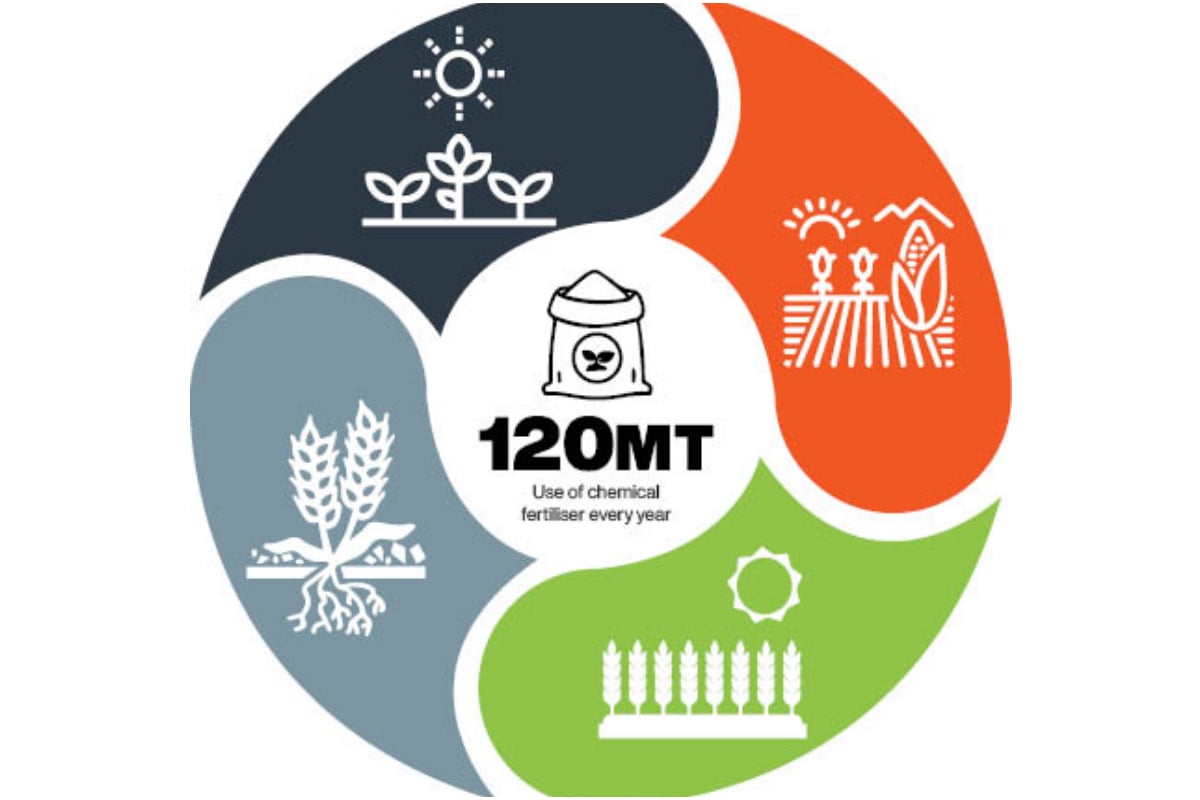
Save Our Soil
Lahore: Intensive use of nitrogen-based fertilisers for better plant growth and yield is causing serious environmental and health hazards, according to various studies.
The use of some 120 million tonnes of chemical fertiliser every year has disturbed the natural “nitrogen cycle”. Less than half of that input is actually absorbed by the plants, with the remaining seeping into the environment and causing a number of problems like soil acidification, leaching nitrogen in groundwater and emissions of nitrous oxide (N2O), a greenhouse gas contributing to global warming.
Excess nitrogen in the atmosphere produces ammonia and ozone, which can cause difficulties in breathing, limit visibility and damage plant growth. When excess nitrogen comes back from the atmosphere, it can damage forests and pollute soils and waterways.
According to a study, the growing use of nitrogen-based fertilisers for food production is increasing emissions of a greenhouse gas 300 times more potent than carbon dioxide.
The efficiency of fertiliser can be increased and losses reduced by matching supply with the crop demand, optimising split application schemes and the use of slow-release fertilisers.
In addition, higher plant densities, weed and pest control and balanced fertilisation with other nutrients can also increase the efficiency of the nitrogen use. Adding mulch to soil can also help, as it uses up nitrogen when it breaks down.
Properly utilising fertilisers by only applying it in periods, where there is less rainfall and when it is needed, can effectively reduce the water runoffs and infiltration of nitrates underground.
According to a study in Nature, carried out by a group of international researchers headed by Zhejiang University Professor Baojing Gu, the benefits of slashing agricultural nitrogen pollution are some 25 times higher than the implementation costs of around $34 billion.
Nearly half-a-trillion dollars in avoided costs are spread across reduced premature deaths from air pollution, less damage to the ecosystem services and increased crop yields. Advanced nitrogen management has upfront costs that would be beyond the reach of small farmers without the backing of strong government policies.
To initiate this, a financial budget could be secured by taxing the food consumers or enterprises that use farming for commercial food production, or by taxing polluting activities and products.

Aamer Hayat Bhandara, a progressive farmer from Pakpattan and the co-founder of Agriculture Republic and Digital Dera, said that climate-smart agriculture is key to cope with the climate change and minimise pesticides and fertilisers-related damages.
He suggested taking all possible measures to minimise the disturbance of the natural nitrogen cycle.
Nitrogen forms nearly 80 per cent of the atmosphere and is critical for the survival of all life on earth, especially plants.
It is made available to plants when microbes that live within the plants or soils turn it into ammonia through biological nitrogen fixation. This process funnels some 200 million tonnes of nitrogen into the soil and oceans every year.
Various forms of the element are eventually transformed and find their way back into the atmosphere with the help of bacteria, especially in wetlands and after leaching into the oceans or being burned.
“We need to adapt and build resilience to climate change, increase crop productivity and reduce greenhouse gas emissions. There is a need to resolve administrative and management-related issues in the agriculture sector. Then we should focus on research and development for introducing crop varieties that could bear the hardships of climate change and use atmospheric nitrogen for proper growth.”
“Mulching, proper water management, boundary trees and appropriate housing and feeding for cattle are the need of the hour,” Bhandara said, adding that planting legumes such as beans or peas in between other crops can provide a nature-based solution to convert nitrogen gas from the air to a form usable by plants. It could also help reduce the use of fertilisers, he added.
“There is a need to take effective measures to ensure the use of fertilisers according to the actual needs,” he said, adding that it would not only reduce the input cost of the growers but would also help minimise the damage to the environment.
For Bhandara, giving proper water to the fields at an appropriate time and the use of fertilisers only in the required quantity to safeguard the health of farm workers and minimise the damages to the environment.
He lamented that the situation was going from bad to worse due to the absence of proper extension services for predominantly uneducated rural communities.
“There is a need to educate and enable the farmers to adopt climate-smart agriculture to resolve the present day and future problems,” he added.

Muhammad Asim, CropLife Biotechnology Committee lead, stressed the need to carry out a detailed study for assessing the actual situation and taking steps accordingly.
“We are always behind in every field whether it is technology adoption or carrying out representative surveys. In this scenario, we depend on surveys of other countries. One thing is clear that the damage of intensive use of fertilisers is much more than our imagination. We need to take every possible step to minimise the fertiliser-related damages,” he said, adding that one such method is crop rotation.
“In the US, soyabean and corn are planted in rotation. The plantation of a variety of crops on the same plot of land optimise the flow of nutrients in the soil. Moreover, leaving crops residue in the fields can provide the much-needed organic matter, which will ultimately help reduce the use of synthetic fertilisers,” he said, adding that growing legumes such as peas and beans along with major crops was also a possible step for optimum use of atmospheric nitrogen.
Asim suggested regular soil analysis before sowing to identify the actual requirements of nutrients for the crop.
“The farmers usually follow blanket recommendations regarding the use of nutrients. In such a scenario, the application of fertilisers is much more than the actual needs and as such the monetary loss to the farmers and damage to the environment.
The government should improve extension services and enable the farmers to get regular soil analysis for the application of fertilisers according to the actual needs,” he said.
Catch all the Economic Pulse News, Breaking News Event and Latest News Updates on The BOL News
Download The BOL News App to get the Daily News Update & Live News.








 Read the complete story text.
Read the complete story text. Listen to audio of the story.
Listen to audio of the story.